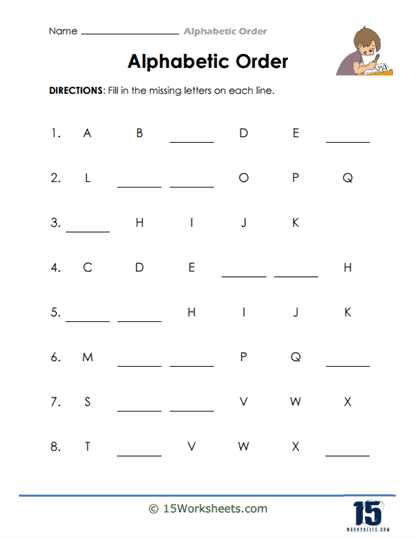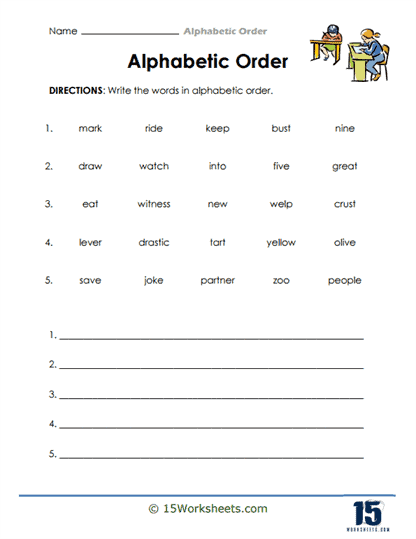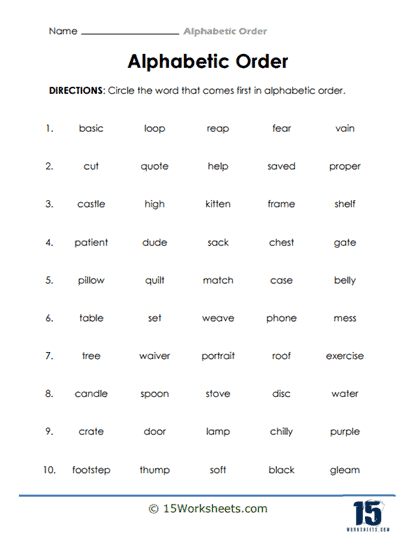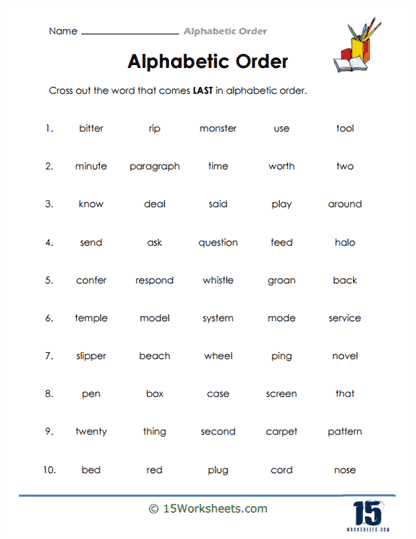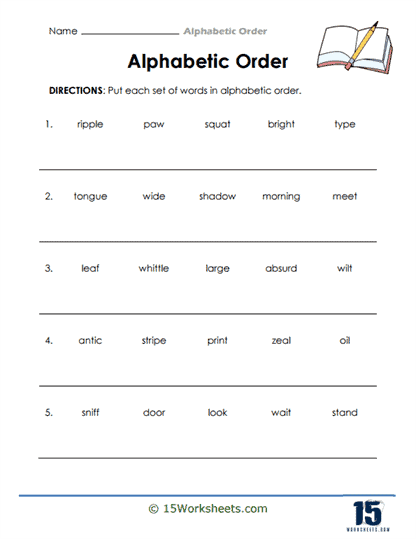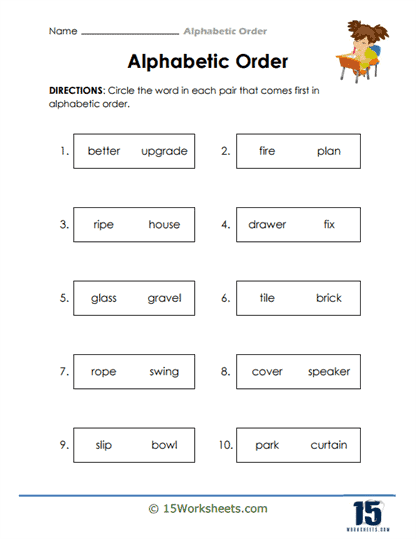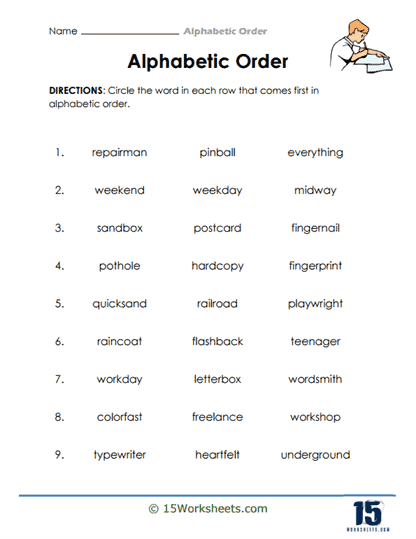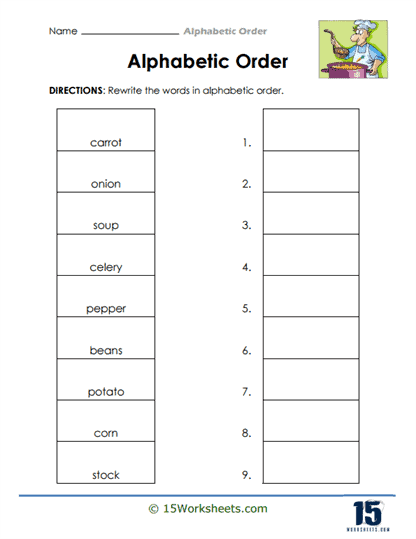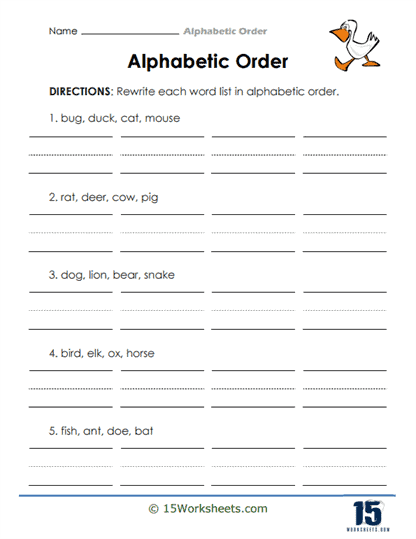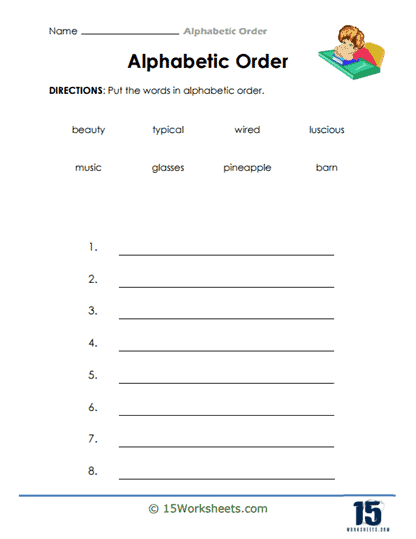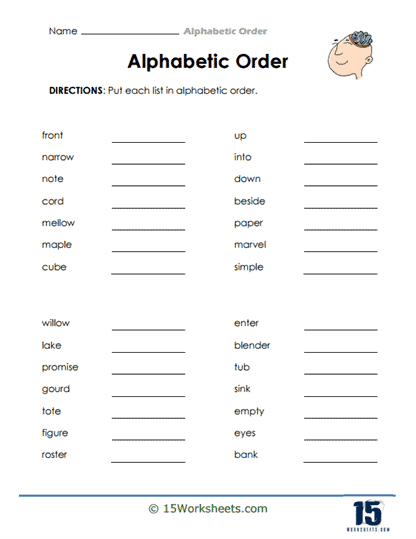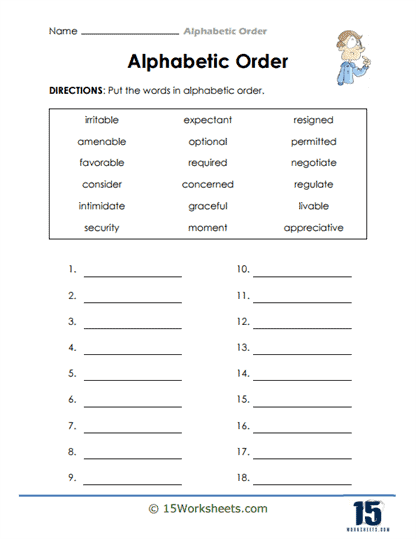Alphabetic Order Worksheets
About These 15 Worksheets
Our alphabetic order worksheets were created to help children learn and practice arranging words, letters, or groups of items in alphabetical order. The purpose of these worksheets is to develop an understanding of the sequence of letters in the English alphabet and enhance organizational skills.
The English alphabet consists of 26 letters, ranging from A to Z. Alphabetic order refers to the arrangement of words or letters based on their position in the alphabet. It follows a consistent sequence from A to Z, with each letter having a specific place in the order.
You will find these different types of exercises across the worksheet series:
Word Sorting – Alphabetic order worksheets often involve sorting words into alphabetical order. You may be given a list of words that are jumbled or not in order, and your task is to rearrange the words correctly from A to Z. This activity helps you practice recognizing the order of letters in the alphabet and applying it to organizing words.
Letter Sequencing – Some worksheets focus on arranging individual letters in alphabetical order. This activity helps reinforce your understanding of the sequence of letters and their positions in the alphabet. Children may need to arrange groups of words or phrases in alphabetical order based on the first letter of the first word in each phrase. You’ll practice identifying and organizing letters based on their alphabetical order.
Multiple Words or Lists – Alphabetic order worksheets may include groups of words or lists that need to be sorted in alphabetical order. This exercise challenges you to recognize patterns, compare words, and order multiple items accurately. It helps you develop skills in organizing information systematically.
Picture Association – To make the activity more engaging, some worksheets may include pictures or illustrations associated with the words. This visual representation can help you make connections between the words and their alphabetical order. It adds a fun element to the learning process.
What Are The Benefits of These Worksheets?
Improving Alphabet Recognition – By practicing alphabetic order regularly, you’ll enhance your familiarity with the letters of the alphabet, their sequence, and their positions. Sorting words or letters in alphabetical order requires systematic thinking and organization. This skillset extends beyond language and becomes valuable in various aspects of life, such as organizing files, arranging lists, or categorizing information. They involve analyzing and comparing words or letters. You’ll develop critical thinking skills as you assess similarities, differences, and patterns among the elements.
Enhancing Vocabulary and Language Skills – Working with alphabetic order worksheets exposes you to different words and expands your vocabulary. It also enhances your understanding of word structure and letter combinations. Arranging words or letters in alphabetical order requires attention to detail. You’ll practice focusing on individual elements and their precise positions, honing your ability to spot patterns and differences.
Alphabetic order worksheets offer a structured and interactive way to reinforce your understanding of the alphabet, enhance your organizational skills, and expand your vocabulary. These worksheets can be used at school, during homeschooling, or as supplementary materials for self-paced learning. They provide an enjoyable way to practice and improve your alphabet recognition while developing important skills that will benefit you in various academic and real-life scenarios.
How to Teach Alphabetizing
Teaching alphabetizing is an essential skill that helps children organize information, develop their understanding of alphabetical order, and improve their language and literacy abilities. Here is a detailed step-by-step approach on how to effectively teach alphabetizing:
Introduce the Concept – Begin by explaining what alphabetical order means. Use visual aids such as an alphabet chart or flashcards to demonstrate the sequence of letters from A to Z. Emphasize that alphabetizing involves arranging words or groups of items in the same order as the letters of the alphabet. Provide simple examples of words or objects and ask students to identify the first letter of each word. For instance, show a set of three words – “cat,” “dog,” and “apple.” Ask students to determine which word comes first in alphabetical order by identifying the initial letter. In this case, “apple” would be first since “a” comes before “c” and “d.”
Guided Practice – Engage students in guided practice by providing a list of words or objects and guiding them through the process of alphabetizing. Start with a small set of words or items that have distinct initial letters. Model the process by thinking aloud and explaining your reasoning as you place them in order. Encourage students to actively participate by suggesting the correct positions of the words. Offer various sorting activities to reinforce alphabetizing skills. Provide sets of word cards, object cards, or lists for students to organize in alphabetical order. Encourage them to work individually or in pairs, focusing on comparing the initial letters of the words or objects to determine their correct positions. Monitor their progress and offer support as needed.
Gradual Complexity – As students become more comfortable with alphabetizing, gradually increase the complexity of the activities. Introduce words with similar initial letters or words that differ only in the later letters. This challenges students to pay attention to the subsequent letters to determine their correct order. Move beyond single words and introduce the concept of alphabetizing sentences or short paragraphs. Provide sets of sentences and ask students to arrange them in alphabetical order based on the first word or the first significant word in each sentence. This activity strengthens their understanding of alphabetical order and introduces the idea that multiple words can be organized together.
Remember to make alphabetizing activities engaging and interactive by incorporating games, puzzles, or online resources. Celebrate students’ progress and provide positive feedback to motivate and encourage their learning journey. With consistent practice and guidance, students will develop strong alphabetizing skills that will benefit them across various subjects and contexts.

